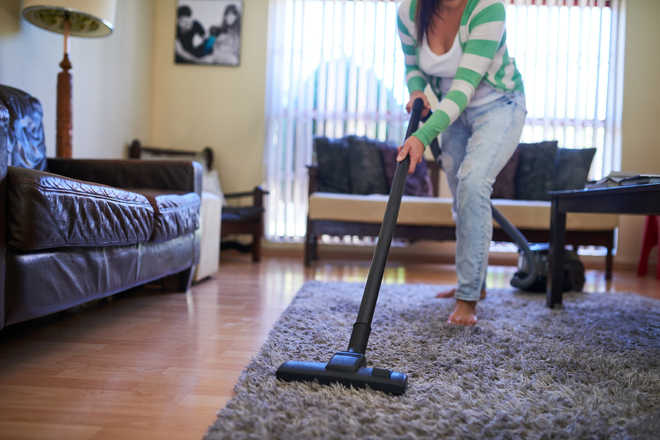
Don’t let the dust settle: Regularly vacuum all carpets, curtains and furnishings, especially heavy ones, as these can entrap dust, and dust mites and can be problematic particularly for asthma patients
Dr Vivek Nangia
Air pollution is an invisible killer. In some homes, the indoor air pollution has been found to be 10-30 times more than outdoor pollution
The common sources of indoor air pollution are:
Cigarette smoke: Smoke from cigarettes, cigars and pipes contain over 4,000 harmful chemicals — 50 of these are known to cause cancer. Two-thirds of the smoke from a cigarette isn’t inhaled by the smoker, it enters the air around the smoker. This results in passive smoking by the innocent bystanders, which is equally harmful.
Other sources may be burning of incense sticks and smoke from yagya, strong air fresheners and aromatic oils and candles and insecticides can produce volatile organic compounds like nitrogen dioxide. Perfumes and deodorant sprays also contribute to this pollution. Average levels of several organic compounds in the indoor air are two to five times higher than outdoors. During certain activities, such as paint-stripping, and for several hours immediately afterwards, pollution levels may be 1,000 times higher than outdoor levels. Use of mosquito-repellent coils, glues and resins also increases these levels.
Many household cleaners contain dangerous toxic compounds like ether-based glycol and terpenes. Synthetic building materials, toxic paints which may contain lead can have a great negative impact on health.
Heavy carpets, curtains and furnishings that entrap dust, dust mites, kitchen fumes, faulty equipment which emits smoke when used — all these are major culprits behind indoor pollution.
Fifty-two per cent of world’s population relies on biomass fuel. More than 90 per cent rural households in developing countries use biomass fuel in one or other form. These fuels are not burned completely. The unprocessed solid fuels typically release at least 50 times more noxious pollutants than gas. Smoke levels in poorly ventilated households using biomass as cooking fuel may be 100 times of what is considered dangerous.
Other possible sources may be smoke from fireplaces during winters, chullahs used in rural households, dampness and moulds on inside walls, asbestos from insulation and tiles, dander from pet animals who also carry inside dust and mud from the outdoors. Even cleaning and dusting can dislodge dust particles from the floor into the air, which can be then inhaled.
How and why it happens
Many houses lack cross ventilation. Others, which have the provision, keep the doors and windows closed to prevent entry of insects and outdoor pollution and in winters to check cold. As a result, these pollutants keep accumulating and building up pollution levels inside houses. Since the homemakers and children spend more time (nearly 85 per cent of their time) indoors, they are more at risk. But even men or working women, who may be spending a large part of their day outside, are exposed to this polluted air for at least 10-12 hours at night and are affected. While outdoor pollution exposure is only for a few hours, indoor pollution is far much longer than we think.
Also infants and young children have a higher resting metabolic rate and higher rate of oxygen consumption per unit body weight than adults because they have a larger surface area per unit body weight and because they are growing rapidly. Therefore, their exposure to any air pollutant may be greater. In addition to an increased need for oxygen relative to their size, children have narrower airways than do adults. Thus, irritation caused by air pollution that would produce only a slight response in an adult can result in potentially significant obstruction in the airways of a young child and hence more dangerous. Another reason why children are more prone is that their lungs are immature and not yet fully developed.
Invisible danger
A study says babies crawling on the floor inhale pollution equivalent to that of four cigarettes a day. Half a tablespoon of dust contains as much as 1,000 dust mites, and 250 allergenic poop pellets. A study in India estimated the burden of respiratory disease due to indoor air pollution as 1.6 billion to 2 billion sick days per year.
The common diseases that result from indoor pollution are: Dryness or irritation of eyes, nose, respiratory tract and throat, dizziness, fatigue, headaches, irritability, lethargy and nausea, allergies, asthma, hypersensitivity pneumonitis and Legionnaire’s disease, lung cancer, chronic obstructive pulmonary diseases (COPD), pneumonias, tuberculosis and “sick building syndrome”. Volatile compounds can result in damage to liver, kidney, blood system and central nervous system .
Prevention
- Control moisture in your home.
- Use exhaust fans in bathrooms and kitchens.
- Properly maintain all home appliances. Major appliances such as furnaces, heat pumps and central air conditioners and others should be cleaned regularly by a professional.
- Control dust. Keep carpets and curtains clean and dry. Avoid carpets, if possible.
- Encase the pillows, quilts and mattresses in airtight covers that do not allow dust mites or their allergens to pass through. Wash pillows, blanket and bedding regularly at 60 ° C.
- Opt for wood, tile or linoleum flooring rather than fitted carpets. Vacuum clean or use wet mops on floors.
- Ventilate properly and regularly: Open all windows and doors when cleaning, painting, installing new carpets or doing other household projects. At other times, too, ventilate rooms.
- Never burn charcoal indoors.
- Never keep burning heaters/ angeethis in closed rooms.
- Avoid, if possible, dust-collecting textiles and furniture.
- Don’t use strong perfumes, aftershave, deodorants and fragrant flowers inside the house.
- Don’t keep or bring furry animals or birds inside homes.
- Completely forbid smoking inside the houses.
- Do not store gasoline, solvents, or other volatile hazardous chemicals inside a home or attached garage.
- Do not buy furniture and other products containing formaldehyde.
— The writer is Head, Pulmonology, Fortis Flt Lt Rajan Dhall Hospital, New Delhi



























